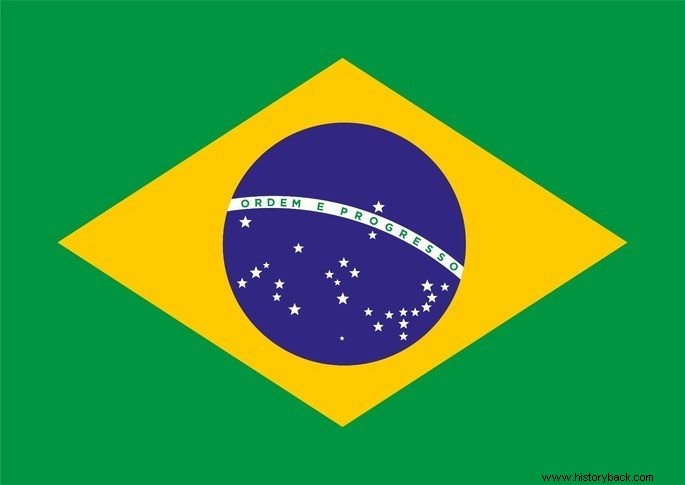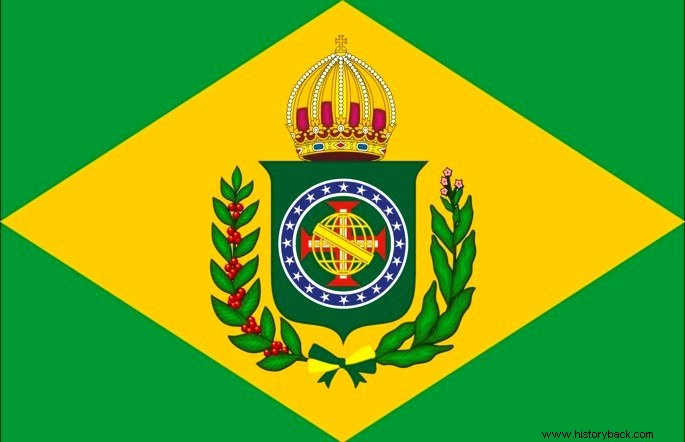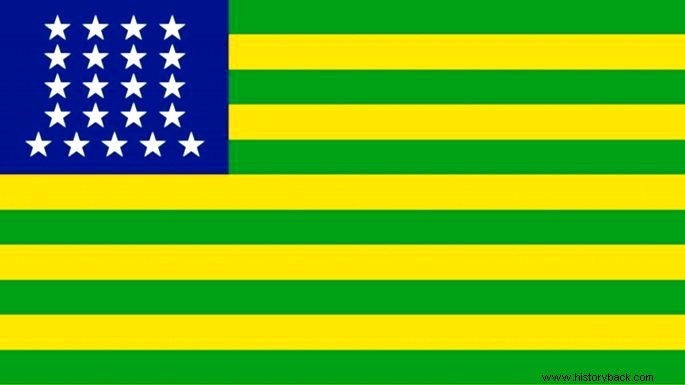The Brazilian flag is composed of a green rectangle, a yellow diamond, a blue circle, 27 white stars and a white band with the inscription "Ordem e Progresso", with the letters in green.

Meaning of the colors of the Brazilian Flag
The colors of the Brazilian flag are officially four:green, yellow, blue and white, and they have the following meanings or representations:
- green - represents the Brazilian vegetation;
- yellow - represents gold and riches;
- blue - represents the sky and Brazilian rivers;
- white - represents the desire for peace.
The current flag retains the green and yellow colors of the imperial flag, but with different meanings.
The green represented the House of Bragança, to which Dom Pedro I belonged, while the yellow represented the House of Habsburg, to which the Empress D. Maria Leopoldina - wife of Dom Pedro I belonged.
Meaning of the Stars on the Flag
The Flag of Brazil contains 27 stars, which represent each of the Brazilian states, including the Federal District.

In the first version of the current flag of Brazil there were 21 stars, which was the number of states plus the Federal District at the time. The 21 stars were drawn in the position they were in the sky in the city of Rio de Janeiro at 8:30 am on November 15, 1889, the date of the Proclamation of the Republic.
Whenever states are added or excluded, the stars on the Brazilian Flag must reflect this change, as provided for in Law No. 8,421, of May 11, 1992. For this reason, the flag now has 27 stars.
Geometric shapes on the Brazilian flag
The national flag is formed by a green rectangle and on it are the following geometric shapes:
Lozenge :represents the women who fought for the independence of Brazil. It is a way of honoring the Empress D. Maria Leopoldina, who played an important role in the country's independence;
Circle :represents a Manueline armillary sphere. The armillary sphere is an instrument used in navigation and recalls the Discovery of Brazil, in which the king of Portugal was D. Manuel I;
Range :among the various interpretations, the band can represent sunlight or the Amazon River.
Positivist Motto of the Brazilian Flag
The flag's sky is "cut" by an ascending white band with the inscription "Ordem e Progresso" in green.
These words are part of a larger phrase:love as a principle, order as a base, and progress as an end. The authorship is by the founder of Positivism, Auguste Comte, whose ideas influenced the creation of the Republic.
Criticism was not spared the choice of these words and several changes were proposed, without success. Among the most significant was that of Senator Antônio Coelho Rodrigues (1846-1912), in 1896, who suggested replacing the inscription with the motto "Lei e Liberdade".
History of the Flag of Brazil
The current model of the Brazilian flag has been used since November 19, 1889, having been modified for the last time in 1992 to comply with Law nº 8.421, of May 11, 1992.
According to the law, each of the stars on the flag must represent the Brazilian states, so as in 1889 there were only 21 states, in 1992 6 stars were added to represent the 26 states and a Federal District.
The flag was designed by Raimundo Teixeira Mendes (1855-1927) and Miguel Lemos (1854-1917), under the guidance of the astronomer of the Imperial Observatory of Rio de Janeiro, Manuel Pereira Reis (1837-1922). The design was inspired by the imperial flag.
About ten flags have represented Brazil since the territory was a colony, through its elevation to the United Kingdom and after independence. Here, we will highlight two of them.
Imperial Flag of Brazil
The first flag of independent Brazil was created by the French painter Jean-Baptiste Debret (1768-1848). At this time, Debret was working at the imperial court.
On the imperial flag, the green represented the coat of arms of the Bragança family, to which Dom Pedro I belonged. The yellow represented the Habsburg dynasty - which ruled Austria - the birthplace of Dom Pedro I's wife, the Empress D. Maria Leopoldina.
In addition to the Habsburg dynasty, yellow also refers to gold and the sun.

Flag of Brazil after the Proclamation of the Republic
After the republican coup, on November 15, 1889, the imperial flag was replaced by a copy of the United States flag in green and yellow colors.
The design did not please anyone and lasted only four days as the national pavilion. Then it was replaced by the current one.

Uses of the Brazilian Flag
The National Flag is hoisted on days of national celebration or mourning. All public offices must display one, as well as schools of all levels, and unions.
Public or private schools must, obligatorily, fly the flag at least once a week throughout the school year. At night, if hoisted, the flag must always be lit.
When several flags are hoisted at the same time, Brazil's flag should be in the center, the first to reach the top and the last to go down.
National Flag Day
National Flag Day was established by Decree nº 4, of November 19, 1889 , which also determined its use.
The measure was among the forms of recognition and reaffirmation of the Republic. The new flag, however, took time to win over the citizens, and it was only with the First Centenary of Brazil's Independence, in 1922, that the flag was popularized.
Anthem to the National Flag
The Anthem to the Flag of Brazil is an exaltation of the nation's greatest symbol.
The lyrics were written by the poet Olavo Bilac (1865-1918) and the music was composed by the conductor Francisco Braga (1868-1945). The anthem exalts the flag as a national symbol, in addition to the natural beauties and dimensions of Brazil.
To learn more, read also :
- Flag Day:November 19
- Anthem to the flag
- National symbols:flag, coat of arms, seal and anthem
